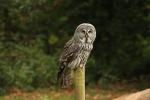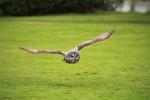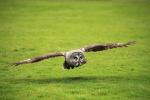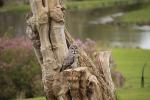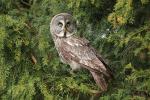Great Grey Owl
The Great Grey Owl (Strix nebulosa) is one of our tallest owls with a broad wingspan and a long tail. They are big headed owls with a large facial disk. They dwarf most other owls in size but not by weight, their bulk is mostly made of feathers. The females are larger than males.
They are silvery grey overall patterned with fine white, grey, and brown streaking with faint barring. Their yellow eyes shine through the fine grey and brown concentric circles of the facial disk. The facial disk is a concave circle of feathers around the eyes of the bird which helps it to collect sound waves and direct them toward the owl's ears, they have excellent hearing, and may locate and capture prey moving beneath 2.0 ft of snow. Two pale arcs form an “X” between the eyes. Across the neck sits a white “bow tie” marking with a black centre. Their bill, if visible, is yellow. Both males and females look very similar.
Great Grey Owls are generally a quiet bird and do not call attention to themselves, they tend to avoid areas with people and quietly perch on the edges of meadows or forests and are nearly invisible to the naked eye despite their size. They hunt at night and during the hours before dawn and dusk. They quietly fly low, on broad wings, over meadows watching and listening for small mammals.
They are found throughout Northern Europe, Northern Asia and a significant proportion of North America. They are quite large birds, rivalling the Eurasian Eagle Owl in size.
The owls diet consists mainly of small mammals and their preferred prey is voles, however they will also eat weasels, squirrels, rabbits, rats and mice. They nest in dense coniferous forests in most of the northern hemisphere.
The female will lay between two to six eggs at one to two-day intervals. The female does all the incubation, which starts when the first egg is laid. After four to six weeks the chick’s hatch. The male provides all the food for the young, which is torn into smaller pieces by the female. When food is scarce the female Great Grey Owl will often starve herself in order to feed her chicks and may lose up to a third of her body weight. The chicks will leave the nest after approximately a month and can fly well after two months. The young stay close to home and are cared for by the female for some time after leaving the nest.
|

